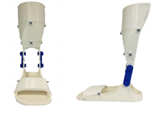Lidyana Roslan1, Shahrol Mohamaddan1, Annisa Jamali1, Saidatul Ardeenawati2
1 Faculty of Engineering, Universiti Malaysia Sarawak, 94300, Kota Samarahan, Sarawak, Malaysia
2 School of Biomedical Electronics Engineering, Universiti Malaysia Perlis
E-mail:
Abstract
The human foot plays an important role in human motion such as standing, walking, running, jumping, balancing, and also helps to withstand the force from body parts. Every person has a gait, or manner of progressive locomotion which is peculiar to that individual (Boehler, Hollander et al., 2008). However, one can have an abnormal gait due to certain disease like foot drop syndrome. The patient tends to walk with an exaggerated flexion of the hip and knee to prevent the toes from catching on the ground during the swing phase. As a result, the force of the heel strike exceeds body weight and the direction of the ground reaction vector passes behind the ankle and knee center throughout the gait. This is because foot drop occurs from a muscular condition caused by problems with the common peroneal nerve or paralysis of the muscles in the anterior region of the lower leg. Some of the most common diseases that can cause foot drop include direct hit to the back of the knee, muscular dystrophy, multiple sclerosis, and cerebral palsy. Complications in a replacement surgery or knee ligament reconstruction surgery may also cause this problem.
To fix the problem, AFO (ankle-foot orthosis) is introduced to patients diagnosed with weakness in the lower limb (Mohamaddan, Ishak et al., 2018). The AFO is a device or brace that covers the foot, ankle, and part of the leg (Chin, Hsiao-Weckler et al., 2009). The approach of AFO is to mechanically lift the foot without trying to replace the muscle action. The device is used to correct the instabilities and joint weaknesses of the lower limb muscle (Kao & Ferris, 2009). AFO was able to improve mobility and can be used as rehabilitation devices to correct the motor patterns (Park, Chen et al., 2011). Moreover, the AFO may improve the walking pattern performance of the user by proper control motion of the device (Peckham & Knutson, 2005). However, AFO is considered bulky in size and only offered a passive approach.
On the contrary, FES (functional electrical stimulation) offers an ‘active’ approach where human muscles and nerves are stimulated that imitates for rehabilitation exercises on targeted muscles to retrain the ‘muscle memory’. FES is the application of electrical current to excitable tissue to supplement or replace function that is lost in neurologically impaired individuals. FES is the application of electrical current to excitable tissue to supplement or replace function that is lost in neurologically impaired individuals (Everaert, Thompson et al., 2010). By using the body’s muscles nerves, there can be some rehabilitation from exercise, and muscle memory can be rebuilt. Therefore, FES can be used in many clinical applications to restore upper extremity, lower extremity, bladder and bowel, and respiratory function. This is why FES is defined as an active approach for lower limb rehabilitation. Likewise, FES is also considered lighter in size compared to the existing method of using AFO. Figure 1 shows the comparrison between a 3D printed APO and a commercial FES walk stimulator.
 |
 |
Figure 1: Left: 3D printed AFO. Right: Commercial FES walk stimulator (Retrieved from Amazon).
The objective of this research is to study the suitable and important human muscle parameters by using FES for lower limb rehabilitation in the effort to find suitable and important human muscle parameters that can improve the lower limb rehabilitation. The understanding of human muscles and their characteristics provides a platform to design the FES circuit and algorithm. By proper placement of the surface electrode on the lower limb, designing the mechanical switch for the overall system, and control the current or voltage for the stimulator, the goal is to reduce pain or discomfort. To achieve this, three important parameters; pulse frequency, amplitude, and duration will be manipulated for stimulation to acquire maximum muscle contraction. The locomotion experiment will be used to study the gait pattern (plantarflexion and dorsiflexion) to validate the finding. This includes manipulating those parameters to control the strength of muscle contraction.
The research outcome is expected to have efficient stimulation (lowest stimulation with the strongest contraction) with lower electrode leads and at the same time reduce pain or discomfort to the patient. The finding may contribute to further understanding of human muscle and propose new methods such as combining the passive and active approach in supporting lower limb rehabilitation.
This research is aligned with the Sarawak Digital Economy Strategy 2018-2022: To increase accessibility and improve the level of medical and health services in rural and remote Sarawak and promote world-class health tourism. The study is supported by Sarawak Research and Development Council.



